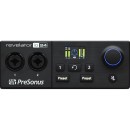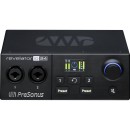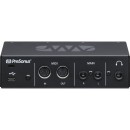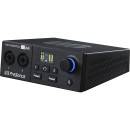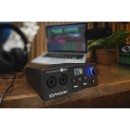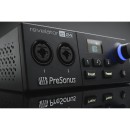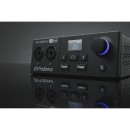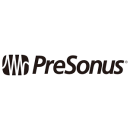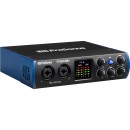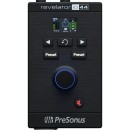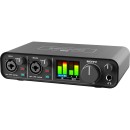PreSonus Revelator io24 USB Audio/MIDI Interface Review
- High-Resolution 24-bit/96 kHz audio quality
- 2x4 USB Type-C audio/MIDI interface
- XMAX-L mic preamps with +48V phantom power
- Loopback audio for streaming and podcasting
- Onboard DSP with FAT Channel processing
- Studio One Artist and Studio Magic software suite included
- Flexible routing and monitoring options
- Zero-latency monitoring with direct monitoring control
- MIDI I/O for MIDI devices
- Compatible with Mac, Windows, iOS, and Android devices
Specifications, Advantages, and Disadvantages
The PreSonus Revelator io24 is a versatile desktop 2x4 USB Type-C audio/MIDI interface designed to meet the needs of podcasters, musicians, and content creators. This compact yet powerful device features two pristine XMAX-L preamps, ensuring high-quality audio capture with low noise and high headroom. It supports sample rates up to 96 kHz, delivering professional-grade sound for any recording or live streaming scenario.
One of the standout features of the Revelator io24 is its built-in DSP effects, which include EQ, compression, and reverb. These effects can be applied in real-time, allowing users to enhance their audio on the fly, whether they are recording in a studio or broadcasting live. The interface also includes loopback channels, making it easy to mix and stream audio from multiple sources, such as DAWs, games, and conferencing apps.
The user-friendly Revelator io24 is equipped with a large, easy-to-read LCD screen for monitoring levels and settings. It connects to your computer via USB Type-C, ensuring fast and reliable data transfer. With its robust construction and intuitive design, the PreSonus Revelator io24 is an excellent choice for anyone looking to achieve professional-quality audio in a desktop-friendly package.
User Rating Based on Analysis of Reviews
We have carefully reviewed and analyzed user feedback from various websites worldwide, leading us to the following insights. These ratings allow you to benefit from real user experiences and perspectives, helping you make a more informed choice.
Purchase Value
85% of users were satisfied with the purchase value of the PreSonus Revelator io24, praising its affordability compared to other interfaces with similar features. Many users highlighted the interface's excellent sound quality and versatile functionality, which they found to be a great bargain within its price range.
15% of users felt dissatisfied with the purchase value, arguing that the price was slightly elevated for beginners who might not utilize all its features. Some also mentioned that they experienced issues that required additional investment in support or replacements.
Quality of Materials
80% of users expressed satisfaction with the quality of materials, noting that the build felt robust and durable. They appreciated the compact design and the sturdy knobs and buttons, which contributed to a reliable user experience over time.
20% of users were not satisfied with the material quality, mentioning that some components felt plasticky and not as durable as expected. A few users reported that the knobs became loose after extended use, raising concerns about long-term durability.
Sound Quality
90% of users were thrilled with the sound quality, highlighting the clean and clear audio output. They frequently mentioned that the preamps delivered professional-level sound, which was a significant advantage for both home studios and professional recording settings.
10% of users were dissatisfied with the sound quality, primarily due to issues with noise interference in specific environments. Some reported that the sound was not as pristine when compared to higher-end interfaces, which affected their recording quality.
Ease of Use
75% of users found the interface to be user-friendly, appreciating the intuitive layout and straightforward setup process. They noted that the accompanying software was easy to navigate, which helped in quickly getting their recording projects underway.
25% of users faced challenges with ease of use, citing a steep learning curve with the software and controls. Some users found the manual insufficient for troubleshooting, leading to frustration during initial setup and configuration.
Software Integration
70% of users were satisfied with the software integration, particularly praising the compatibility with major DAWs and the feature-rich applications that came with the interface. They found the software added significant value to their purchase.
30% of users encountered issues with software integration, reporting frequent glitches and compatibility problems with their existing setups. Some users had difficulty getting the software to recognize the interface, which hindered their recording process.
Portability
88% of users were happy with the portability of the PreSonus Revelator io24, noting its compact size and lightweight design made it perfect for mobile recording. They appreciated being able to easily transport it between different locations without hassle.
12% of users were less impressed with the portability, mainly because they expected additional protective casing for travel. Some expressed concerns about the durability of the unit when frequently moved.
Customer Support
65% of users were satisfied with customer support, citing responsive and helpful staff who provided timely solutions to their issues. They appreciated the guidance and troubleshooting assistance received.
35% of users were dissatisfied with customer support, mentioning long wait times and unhelpful responses. Some users felt that their issues were not adequately addressed, leading to unresolved problems.
Setup Process
78% of users found the setup process straightforward, with many commenting on the clear instructions and ease of installation. The step-by-step guidance provided was deemed sufficient for most users.
22% of users faced difficulties during the setup process, reporting complications with driver installations and connectivity issues. Some users spent additional time troubleshooting due to unclear instructions.
Design Aesthetics
82% of users appreciated the design aesthetics, highlighting its sleek, modern look and intuitive control layout. They felt that the design was not only attractive but also functional, enhancing their studio setup.
18% of users were not entirely satisfied with the design aesthetics, feeling that the interface lacked unique visual appeal. Some users found the design too simplistic and desired more distinctive features.
Durability
77% of users were content with the durability of the interface, noting that it held up well under regular use. They appreciated the sturdy construction that seemed to withstand daily wear and tear.
23% of users were disappointed with the durability, reporting issues such as buttons and connectors becoming loose over time. Some users experienced malfunctions after a few months of use.
Latency
85% of users were satisfied with the low latency performance, praising its effectiveness in ensuring real-time monitoring without noticeable delays. This aspect was particularly appreciated by musicians and podcasters.
15% of users experienced latency issues, which were more pronounced when using specific software or settings. Some found the latency problematic for precise audio production work.
Connectivity Options
84% of users were pleased with the variety of connectivity options, including the USB Type-C interface, which provided fast and reliable connections. The availability of MIDI integration was also a plus for many users.
16% of users were not entirely happy with the connectivity options, citing limited input/output ports for their specific needs. Some users needed additional adapters or equipment to accommodate their setups.
Compatibility
81% of users found the interface compatible with a wide range of devices and software, which facilitated seamless integration into their existing setups. This compatibility was noted as a significant benefit.
19% of users faced compatibility challenges, especially with older operating systems or less common DAWs. Some users needed to update or change their software to ensure proper functionality.
Preamps
88% of users were impressed with the quality of the preamps, noting their clarity and ability to handle various microphones effectively. The preamps were often compared favorably to those in more expensive models.
12% of users were less satisfied with the preamps, finding them insufficient for high-end professional recording. Some users reported distortion at higher gain levels, which affected their recording quality.
Versatility
86% of users appreciated the versatility of the PreSonus Revelator io24, highlighting its multiple use cases for music production, podcasting, and streaming. Users found the interface adaptable across different projects.
14% of users felt the interface lacked versatility, primarily due to limitations in advanced features needed for specific professional applications. Some expressed a desire for more customizable settings.
Size
89% of users were satisfied with the compact size of the interface, which fit well into small studio spaces and made it convenient for desktop setups. The size was particularly praised for not compromising on functionality.
11% of users found the size a limitation, especially those who preferred larger interfaces with more onboard controls. Some felt the size restricted the number of physical inputs available.
Learning Curve
72% of users found the learning curve manageable, with resources like tutorials and community forums aiding them in mastering the interface. They appreciated the logical layout of controls and software.
28% of users struggled with the learning curve, particularly those new to audio interfaces. They pointed out a lack of comprehensive guides to help them fully utilize all features, leading to a prolonged adjustment period.
Power Supply
83% of users were pleased with the power supply options, especially the USB-powered feature which allowed for easy setup without additional power cables. This was seen as a convenient and efficient solution.
17% of users encountered power supply issues, noting that the interface sometimes drew too much power from laptops, leading to connectivity problems. Some users preferred an external power option for stability.
Driver Stability
74% of users were satisfied with the stability of the drivers, reporting minimal crashes or interruptions during use. The steady performance was crucial for uninterrupted recording sessions.
26% of users faced driver stability issues, experiencing occasional disconnections and software crashes. These interruptions were particularly problematic during live recordings and broadcasts.
Brand Reputation
90% of users trusted PreSonus as a reputable brand, citing positive past experiences and reliable products. The brand's reputation for quality and innovation contributed to their purchase decision.
10% of users were skeptical about the brand reputation, often due to prior issues with PreSonus products or support. Some users felt the brand overpromised on features that didn't meet their expectations.
In the following sections, we will delve into the detailed specifications of the PreSonus Revelator io24 Desktop 2x4 USB Type-C Audio/MIDI Interface. This comprehensive review will also highlight its advantages and disadvantages to help you make an informed decision.
Pros:
- High-quality audio performance with 24-bit/96 kHz resolution.
- USB Type-C connectivity for fast and reliable data transfer.
- Built-in DSP for real-time effects processing.
- Compact and portable design, ideal for desktop use.
- Includes PreSonus Studio One Artist DAW software.
- Easy-to-use interface with clear visual feedback.
Cons:
- Limited to 2x4 I/O, which might not be sufficient for larger setups.
- Higher price point compared to some other desktop interfaces.
- Requires a compatible USB Type-C port or adapter.
- Some users may find the learning curve for the DSP effects to be steep.
General
| Channels of I/O | Analog: 2 Inputs / 4 Outputs |
|---|---|
| Maximum Sampling Rate | 96 kHz / 24-Bit |
| Number of Microphone Inputs | 2 Preamps |
| Input Level Adjustment | 1x Knob |
| Expansion Slots |
The PreSonus Revelator io24 Desktop audio interface offers a range of specifications that cater to various audio recording and production needs. Show More
Starting with the Channels of I/O, the device features 2 inputs and 4 outputs. This configuration allows users to connect two microphones or instruments while having the flexibility to route audio to multiple outputs, which is particularly useful for live performances or complex studio setups.
The Maximum Sampling Rate of 96 kHz at 24-Bit indicates the audio quality the device can handle. Higher sampling rates and bit depths lead to more accurate sound reproduction and greater dynamic range, making this interface suitable for professional audio recordings.
There are Number of Microphone Inputs which is equipped with 2 preamps. Preamps are essential for boosting the audio signal from microphones to a usable level, and having two allows for simultaneous recording of multiple sources, such as vocals and instruments.
For Input Level Adjustment, the interface features a single knob for easy control. This simplicity allows users to quickly adjust the input gain to ensure optimal recording levels without complicated settings, making it user-friendly.
Lastly, the Expansion Slots indicate that the Revelator io24 does not have additional slots for future upgrades or additional hardware. While this may limit expandability, it keeps the interface compact and straightforward for users who do not require further enhancements. Overall, these specifications highlight the Revelator io24 as a versatile and high-quality audio interface suitable for various recording applications.
Signal Processing
| Pad | |
|---|---|
| Gain/Trim Range | Mic Inputs: 60 dB Hi-Z Inputs: 50 dB |
| High-Pass Filter | 80 Hz |
| Solo/Mute | Mute per Master |
The Pad feature refers to a signal attenuation mechanism that reduces the input level for high-output sources, preventing distortion and clipping. In the case of the PreSonus Revelator io24, the absence of a pad means that users will need to be cautious when connecting particularly loud instruments or microphones, as the interface is designed to handle standard input levels without additional attenuation.Show More
The Gain/Trim Range indicates the amount of amplification available for the mic and Hi-Z inputs. For mic inputs, a range of 60 dB allows for significant boost, accommodating various microphone types, from low to high sensitivity. The 50 dB gain for Hi-Z inputs is suitable for instruments like electric guitars or basses, enabling them to be recorded effectively without compromising sound quality. Having a wide gain range is essential for achieving the desired recording levels and overall sound clarity.
The High-Pass Filter at 80 Hz is a useful feature that eliminates low-frequency noise and rumble, which can clutter the mix and detract from the quality of the recording. This filter is particularly beneficial when recording vocals or instruments, as it helps to focus on the essential frequencies without the interference of low-end sounds.
Finally, the Solo/Mute functionality allows users to isolate or silence specific audio channels, enhancing mixing and monitoring capabilities. The ability to mute the master output can be particularly useful in live settings or during mixing sessions, as it enables users to focus on specific tracks without the distraction of other audio sources. This feature is essential for achieving a precise and well-balanced mix.
Connectivity
| Analog Audio I/O | 2x Combo XLR-1/4" TRS Balanced/Unbalanced Mic/Line/Hi-Z Input (Front Panel) 2x 1/4" TRS Balanced Monitor Output 1x 1/4" TRS Unbalanced Headphone Output |
|---|---|
| Phantom Power | 48 V, Selectable On/Off (Selectable on Individual Inputs) |
| Digital Audio I/O | |
| Host Connection | 1x USB-C |
| Host Connection Protocol | USB 2.0 |
| USB (Non-Host) | |
| Sync I/O | |
| Network I/O | |
| MIDI I/O | 1x DIN 5-Pin Input 1x DIN 5-Pin Output |
The PreSonus Revelator io24 is equipped with a variety of audio inputs and outputs that cater to different recording and monitoring needs. Show More
Starting with the Analog Audio I/O, this interface features two combo XLR-1/4" TRS inputs on the front panel, which allow for balanced or unbalanced connections for microphones, line-level signals, or high-impedance instruments. This versatility is crucial for users who may want to connect various types of audio sources. Additionally, it includes two balanced 1/4" TRS monitor outputs for connecting studio monitors and a 1/4" TRS unbalanced headphone output for direct monitoring. This setup ensures that users can easily route audio for recording or playback.
The Phantom Power feature is particularly important for those using condenser microphones, as it provides the necessary 48V power to operate these microphones. The selectable on/off option for phantom power on individual inputs adds flexibility, allowing users to choose which inputs require this feature, thus optimizing their setup.
In terms of Digital Audio I/O, the Revelator io24 does not include any digital input or output options, focusing instead on analog connections. The Host Connection is via a single USB-C port, operating under USB 2.0 protocol, which is standard for many audio interfaces, ensuring compatibility with most computers and devices.
The device does not support USB (Non-Host) connections, which means it cannot function as a USB hub or connect to other USB devices directly. Furthermore, there are no Sync I/O or Network I/O capabilities, indicating that it is designed primarily for straightforward audio input and output tasks without the complexities of networked audio systems.
Lastly, the MIDI I/O functionality is provided through a traditional DIN 5-Pin format, offering one input and one output. This allows users to connect MIDI controllers or other MIDI devices, facilitating the integration of MIDI data into their audio recordings and performances. Overall, these specifications highlight the Revelator io24 as a robust interface, designed primarily for analog audio applications with essential MIDI capabilities.
Performance
| Frequency Response | Mic, Hi-Z Inputs: 20 Hz to 20 kHz +0.1/-0.3 dB (Unity Gain) Monitor Outputs: 20 Hz to 20 kHz +0.1/-0.3 dB (Unity Gain) Headphone Outputs: 20 Hz to 20 kHz +0.1/-0.5 dB |
|---|---|
| Maximum Input Level | Mic/Hi-Z Inputs: +10 dBu (Min Gain) |
| Maximum Output Level | Monitor Outputs: +10 dBu (Balanced, 1 kHz) |
| Headphone Output Power | 40 mW per Channel into 56 Ohms (Max) |
| Impedance | Mic Inputs: 1.4 Kilohms (Balanced) Hi-Z Inputs: 1 Megohm Headphone Outputs: 32 to 300 Ohms |
| Dynamic Range | AD/DA Converters: 105 dB |
| THD+N | Mic Inputs: 0.009% (1 kHz, Min Gain, at -1 dBFS) Monitor Outputs: 0.003% (1 kHz, Unity Gain, at -1 dBFS) Headphone Outputs: 0.01% (1 kHz, at 0 dBFS) |
| EIN | Mic Inputs: -126 dBu A-Weighted (150-Ohm Source, Max Gain) |
The specifications of the PreSonus Revelator io24 provide crucial insights into its performance characteristics, ensuring that users can achieve high-quality audio recordings and playback. Show More
Frequency Response refers to the range of frequencies that the device can reproduce accurately. For the mic and Hi-Z inputs, as well as the monitor outputs, the frequency response spans from 20 Hz to 20 kHz, with minimal variation. This wide frequency range is essential for capturing the full spectrum of audio, from the deepest bass notes to the highest treble sounds, which is particularly important for music production and professional audio applications. The headphone outputs also maintain a similar frequency response, ensuring that users can monitor audio accurately.
Maximum Input Level indicates the highest level of input signal that the device can handle without distortion. For the mic and Hi-Z inputs, a level of +10 dBu at minimum gain ensures that the interface can accommodate strong signals from various sources, maintaining audio clarity and integrity.
Maximum Output Level describes the peak output level the device can deliver. The monitor outputs also reach +10 dBu, which is suitable for driving studio monitors effectively. This ensures that the audio signal remains strong and clear when connected to external speakers.
Headphone Output Power pertains to the amount of power delivered to headphones, specified at 40 mW per channel into 56 Ohms. This power output is significant for ensuring that headphones can deliver adequate volume levels without distortion, especially in noisy environments.
Impedance affects how the inputs and outputs interact with connected devices. The mic inputs have an impedance of 1.4 kilohms, while the Hi-Z inputs feature a higher 1 megohm, accommodating various instruments and microphones. The headphone outputs' impedance range of 32 to 300 Ohms allows compatibility with a wide range of headphones, catering to different user preferences.
Dynamic Range indicates the difference between the quietest and loudest sounds that the converters can handle, with a specification of 105 dB for AD/DA converters. A higher dynamic range means better audio fidelity and the ability to capture subtle nuances in recordings.
THD+N (Total Harmonic Distortion plus Noise) measures the distortion level in the audio signal. The low percentages across mic inputs, monitor outputs, and headphone outputs suggest that the interface maintains exceptional audio clarity, minimizing unwanted noise and distortion.
Finally, EIN (Equivalent Input Noise) represents the noise level of the mic inputs. At -126 dBu A-Weighted, this low noise floor means that users can achieve clean recordings without significant background noise, which is essential for professional audio work.
Overall, these specifications highlight the PreSonus Revelator io24 as a high-quality audio interface designed for serious musicians and audio professionals seeking reliable performance and sound fidelity.
Digital Audio
| Sample Rates | 44.1 / 48 / 88.2 / 96 kHz |
|---|---|
| Sample Rate Conversion | |
| Bit Depths | 24-Bit |
| Latency | Zero-Latency Direct Monitoring |
| Sync Sources | Internal |
The specifications of the PreSonus Revelator io24 provide a comprehensive overview of its audio capabilities, which are essential for anyone looking to achieve high-quality recordings and playback. Show More
Sample Rates refer to the frequency at which audio is captured or played back, measured in kilohertz (kHz). The Revelator io24 supports multiple sample rates, including 44.1, 48, 88.2, and 96 kHz. Higher sample rates allow for more accurate audio reproduction and can be particularly beneficial in professional settings, where clarity and detail are crucial.
Sample Rate Conversion indicates whether the device can convert audio from one sample rate to another during playback or recording. In this case, the Revelator io24 does not feature sample rate conversion. This means that users must ensure their input and output devices are operating at the same sample rate to prevent any audio issues.
Bit Depths refer to the number of bits used to represent each audio sample, with a higher bit depth allowing for greater dynamic range and less distortion. The Revelator io24 operates at a bit depth of 24-bit, which is standard in professional audio production and ensures that recordings capture a wide range of sounds, from the softest to the loudest, without losing quality.
Latency is the delay between input and output, which can be critical in live recording situations. The Revelator io24 offers zero-latency direct monitoring, allowing users to hear their input signal in real-time without any delay. This feature is particularly useful for musicians and vocalists who need to monitor their performance accurately while recording.
Sync Sources indicate the timing references used by the audio interface for synchronization purposes. The Revelator io24 has an internal sync source, meaning it generates its own clock signal to manage audio timing. This is a common setup for standalone interfaces and is suitable for most recording scenarios.
Overall, these specifications highlight the Revelator io24 as a versatile and capable audio interface, ideal for both beginners and seasoned professionals looking for reliable performance in their audio projects.
Audio Storage & Playback
| Memory Card Slot |
|---|
The PreSonus Revelator io24 does not come equipped with a memory card slot. This means that users cannot expand storage or directly record audio onto an external memory card, which is a feature found in some other audio interfaces. Instead, the Revelator io24 relies on a USB connection to transfer audio data to a computer or recording device, which is typically faster and allows for more efficient handling of high-quality audio signals.Show More
The absence of a memory card slot does not detract from the overall functionality of the Revelator io24, as it is designed primarily for studio and home recording environments where audio is captured directly onto a computer. Users should consider their specific recording needs; if they require portability or standalone recording capabilities, they might look for other devices that offer built-in storage options. However, for those focused on high-quality audio input and output with seamless integration into a computer-based setup, the Revelator io24's design is well-suited to those requirements.
Compatibility
| OS Compatibility | macOS 10.13 or Later (64-Bit Only) Windows 10 (64-Bit Only) 9.0.3 or Later |
|---|---|
| Processor Requirement | Mac: Intel Core i3 or Better PC: Intel Core i3 or Better AMD A10 or Better |
| RAM Requirements | 4 GB, 8 GB Recommended |
| Storage Requirements | 30 GB |
| Minimum Display Resolution | 1366 x 768 |
| Mobile Device Compatibility | iPad Pro (with USB-C) iPad Air (with USB-C) iPad Mini with Retina (with USB-C) iPad 4th Gen. (with USB-C) Android Smartphone (with USB-C) Android Tablet (with USB-C) |
| Required Hardware | Available USB 2.0 Port or USB-C Port USB Cable (Included) |
| Internet Connection | Required for Registration, Software/Driver Download |
The OS Compatibility feature indicates the operating systems that are supported by the PreSonus Revelator io24 audio interface. This unit is compatible with macOS versions 10.13 and later (64-bit only) and Windows 10 (64-bit only). Users must ensure their operating system meets these requirements for optimal performance and functionality.Show More
The Processor Requirement specifies the minimum processor specifications necessary to run the audio interface effectively. For Mac users, an Intel Core i3 or better is required, while Windows users need at least an Intel Core i3, AMD A10, or a superior processor. This ensures that the device can handle audio processing tasks without latency or performance issues.
The RAM Requirements detail the amount of memory needed to smoothly operate the interface. A minimum of 4 GB of RAM is necessary, though 8 GB is recommended for better performance, particularly when running multiple audio applications or plugins simultaneously.
The Storage Requirements state that users need at least 30 GB of available storage space. This is important for installing necessary software and drivers, as well as for storing audio files and projects.
The Minimum Display Resolution requirement of 1366 x 768 ensures that users have a sufficiently clear display to interact with the software and interface controls. A higher resolution can enhance usability and visibility of details.
The Mobile Device Compatibility section lists the specific iPad and Android devices that can connect to the Revelator io24 via USB-C. This feature enables users to utilize the interface with a range of mobile devices, enhancing portability and versatility in audio recording and production.
The Required Hardware includes the need for an available USB 2.0 or USB-C port, along with a USB cable (which is included with the device). This is crucial for establishing a connection between the interface and the computer or mobile device.
Lastly, the Internet Connection requirement highlights the necessity of having internet access for registering the device and downloading necessary software or drivers. This step is essential to unlock the full potential of the audio interface and ensure it operates correctly.
Power
| Power Requirements | USB Bus Power |
|---|
The Power Requirements specification refers to the means by which the PreSonus Revelator io24 audio interface receives its power. In this case, it operates via USB Bus Power, which means it draws power directly from the computer or device it is connected to through the USB port. This feature is particularly advantageous for users who prefer a streamlined setup without the need for an additional external power supply. Show More
USB bus-powered devices are generally more portable and easier to use, especially for mobile recording or live setups, as they eliminate the clutter of extra cables and power adapters. It also simplifies the setup process, allowing users to connect and start working quickly. However, it is essential to note that the power provided through USB ports may vary depending on the host device, which can impact the performance of the audio interface, especially when using multiple devices or high-powered peripherals.
Physical
| Anti-Theft Features | Kensington Security Slot |
|---|---|
| Dimensions | 6.25 x 6.25 x 2.5" / 15.88 x 15.88 x 6.3 cm |
| Weight | 2.0 lb / 0.9 kg |
The Anti-Theft Features of the PreSonus Revelator io24 include a Kensington Security Slot, which is a standard feature found on many electronic devices. This slot allows users to secure the audio interface to a stationary object using a compatible lock, helping to prevent theft in public or shared spaces. This is especially important for musicians and audio professionals who may transport their equipment frequently.Show More
The Dimensions of the Revelator io24 are 6.25 x 6.25 x 2.5 inches (15.88 x 15.88 x 6.3 cm). These compact dimensions make it an ideal choice for desktop setups, allowing it to fit comfortably in smaller workspaces without sacrificing functionality. The size is designed to balance portability and usability, making it easy to transport while still providing all necessary features for audio recording and playback.
With a Weight of just 2.0 lb (0.9 kg), the Revelator io24 is lightweight and portable, making it convenient for musicians and audio engineers on the go. Its lightweight design does not compromise on build quality, ensuring durability while maintaining ease of transport. This feature is particularly advantageous for users who travel frequently for gigs, studio sessions, or collaborations, as they can easily carry the device without adding significant weight to their gear.
Packaging Info
| Package Weight | 2.41 lb |
|---|---|
| Box Dimensions (LxWxH) | 8.5 x 8.4 x 5.2" |
The Package Weight of the PreSonus Revelator io24 is 2.41 lb, which refers to the total weight of the product when packaged for shipping. This weight is important for users to consider when calculating shipping costs or handling the device, as it gives an idea of how portable the interface is. A lightweight audio interface is generally easier to transport, making it suitable for mobile recording setups or for musicians who travel frequently.Show More
The Box Dimensions (LxWxH) are 8.5 x 8.4 x 5.2 inches, indicating the physical size of the packaging. These dimensions provide insight into how much space the device will occupy during storage or transport. A compact size can be advantageous for users with limited space, whether on a desk or in a travel bag. Additionally, understanding box dimensions helps users plan for setup and integration into their existing gear, ensuring that it fits well within their workspace.
Customer Images
Customer Questions
How do I set up the PreSonus Revelator io24 for the first time?
To set up the PreSonus Revelator io24, first connect the interface to your computer using the included USB Type-C cable. Then, download and install the Universal Control software from the PreSonus website. Once installed, open Universal Control to update the firmware if necessary and configure your audio settings.
Why isn't my computer recognizing the Revelator io24?
If your computer isn't recognizing the Revelator io24, make sure the USB cable is securely connected. Try using a different USB port or cable if the problem persists. Ensure that you have installed the latest Universal Control software and drivers from the PreSonus website.
How do I update the firmware on the Revelator io24?
To update the firmware, open the Universal Control software after connecting your Revelator io24 to your computer. If a firmware update is available, you will be prompted to install it. Follow the on-screen instructions to complete the update.
Why am I getting no sound from my speakers or headphones?
Ensure that your input and output settings in your DAW and Universal Control are correctly configured. Make sure your speakers or headphones are properly connected to the appropriate output on the Revelator io24. Check the volume levels and ensure the interface is not muted.
How do I configure the loopback feature on the Revelator io24?
In the Universal Control software, navigate to the 'Loopback' tab. Here you can configure your loopback settings by selecting the source channels you want to loop back. Adjust the levels and routing to suit your needs.
What sample rates does the Revelator io24 support?
The PreSonus Revelator io24 supports sample rates of 44.1 kHz, 48 kHz, 88.2 kHz, and 96 kHz.
How do I set the gain levels on the inputs?
You can set the gain levels on the inputs by using the gain knobs located on the front of the Revelator io24. Adjust the knobs until you achieve the desired input level. You can also monitor and adjust gain levels in the Universal Control software.
Why is there latency when I record or monitor audio?
Latency can be minimized by lowering the buffer size in your DAW and Universal Control settings. However, reducing buffer size can increase CPU usage, so find a balance that works for your system. Ensure that you are using the latest drivers and firmware.
Can I use the Revelator io24 with my iOS device?
Yes, the Revelator io24 is compatible with iOS devices. You will need a USB-C to Lightning or USB-C to USB-C cable, depending on your device. Make sure your iOS device is running the latest software version.
How do I connect MIDI devices to the Revelator io24?
The Revelator io24 has a MIDI input and output. Use standard MIDI cables to connect your MIDI devices to the MIDI ports on the back of the interface. Configure your MIDI settings in your DAW and Universal Control software to start using your MIDI devices.
Comparison
← SWIPE THE TABLE TO SEE MORE →
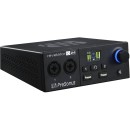
PreSonus Revelator io24 |
VS | |||
|---|---|---|---|---|
| Analog: 2 Inputs / 4 Outputs |
Channels of I/O |
Analog: 2 Inputs / 2 Outputs at 192 kHz |
4 Inputs / 2 Outputs |
Analog: 2 Inputs / 2 Outputs |
| 96 kHz / 24-Bit | Maximum Sampling Rate | 192 kHz / 24-Bit | 96 kHz / 24-Bit | 192 kHz / 24-Bit |
| 2 Preamps | Number of Microphone Inputs | 2 Preamps | 1 Preamp | 2 Preamps |
| 2x Combo XLR-1/4" TRS Balanced/Unbalanced Mic/Line/Hi-Z Input (Front Panel) 2x 1/4" TRS Balanced Monitor Output 1x 1/4" TRS Unbalanced Headphone Output |
Analog Audio I/O |
2x Combo XLR-1/4" TRS Balanced/Unbalanced Mic/Line/Hi-Z Input 2x 1/4" TRS Balanced Line/Monitor Output 1x 1/4" TRS Unbalanced Headphone Output |
1x Combo XLR-1/4" TS Balanced/Unbalanced Mic/Hi-Z Input 1x 1/8" / 3.5 mm TRS Unbalanced Line Input 1x 1/8" / 3.5 mm TRRS Unbalanced Headset In/Out 2x 1/4" TRS Balanced Monitor Output |
2x Combo XLR-1/4" TRS Balanced/Unbalanced Mic/Line/Hi-Z Input 1x 1/4" TRS Unbalanced Headphone Output 2x 1/4" TRS Balanced Line Output (DC-Coupled) 2x RCA TS Unbalanced Line Output |
| 1x USB-C | Host Connection | 1x USB-C (Class-Compliant) | 1x USB-C | 1x USB-C |
| macOS 10.13 or Later (64-Bit Only) Windows 10 (64-Bit Only) 9.0.3 or Later |
OS Compatibility |
macOS 10.13 or Later (64-Bit Only) Windows 10 or Later (64-Bit Only) |
macOS 10.13 or Later Windows 10 or Later Chrome OS iPadOS |
macOS 10.11 or Later Windows 7 or Later 9 or Later |
| USB Bus Power | Power Requirements | USB Bus Power | USB Bus Power | USB Bus Power |
